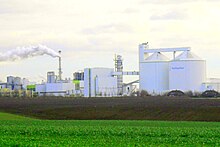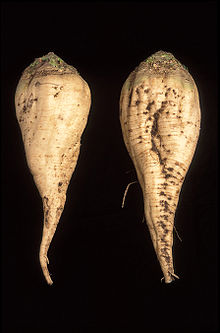Sugar plant
As sugar cane plants are called, carried their cultivation for the production of sugar. The most important sugar crops are sugar cane and sugar beet . The disaccharide (double sugar) sucrose ( table sugar , also called cane or beet sugar , depending on its origin ) is obtained from these . This consists of the two glycosidically linked monosaccharides (simple sugars) glucose (grape sugar) and fructose (fruit sugar). The high-energy carbohydrateSucrose serves as an energy store for sugar plants. The sucrose obtained from the plant is z. B. used as food or for the production of bioethanol .
The household sugar sucrose is called sugar. According to the chemical definition, however, polysaccharides such as B. Strength below. This can be broken down into its monomer glucose and used for similar purposes as sucrose. Nevertheless, in this case, we do not speak of sugar, but of starch plants .
Sugar plants
In tropical regions, sugar cane is the most widespread sugar crop, while in the temperate latitudes it is mainly sugar beets that are grown. There are also a large number of other, less important sugar plants:
- Sugar cane
- sugar beet
- Sugar palm
- Sugar maple
- Millet
- Silver date palm
- Honey palm
- Palmyra palm
- Agaves
- Etc.
In addition to these sugar plants, the production of glucose syrup from starch has also gained in importance since the 1970s , especially with maize , potatoes and wheat as raw material plants.
history
Before humans began isolating sugar from plants, honey and concentrated fruit juices were the only ways to sweeten foods. According to recent research, the cultivation of sugar cane began around 8,000 BC. In New Guinea and from there came to India . Around 5,000 BC The production of syrup from sugar cane juice began in the 3rd century BC and around 200–400 AD in India the production of granulated sugar . In addition to sugar from sugar plants, starch plants have also increasingly been used for sugar production since the 1970s. Mainly starch from corn , potatoes and wheat is used to produce glucose syrup . Sugars such as B. glucose and polysaccharides derived from it, such as starch and cellulose , usually make up the largest part of plant biomass. The plants use sucrose and starch as reserve material .
Cultivation and processing
Sucrose is water-soluble and is stored in the plant cells in vacuoles . The sugar is extracted by pressing or leaching with warm water. Until the Crystallization different processing steps are necessary. Sugar cane ( Saccharum officinarum ) is a perennial plant that can be harvested several times. The stalks of the plant are extracted and the sugar juice it contains is extracted by pressing. Sugar beet ( Beta vulgaris ) are biennial plants, but they are harvested in the year of sowing. The beet is chopped up in the sugar factory and the sugar it contains is extracted by leaching.
use
Much of the sugar is used in food. With sugar, however, sugar plants also provide a renewable raw material that z. B. can be used materially for fermentation purposes or is used to provide energy through fermentation to bioethanol. By-products of sugar production, such as B. Bagasse made from sugar cane can be used for energy by incineration. Other proportions, e.g. B. Molasses from sugar beet processing contain sugar and other nutrients, so that it can be used as fodder.
Another, so far less widespread use is the production of biogas from sugar plants. Sugar beet in particular is currently being tested for its suitability as a substrate for biogas plants .
See also
Individual evidence
- ↑ a b G. Franke (ed.): Useful plants of the tropics and subtropics. Volume 3: Special crop production , Ulmer Verlag, Stuttgart-Hohenheim 1994, ISBN 3-8001-2667-2 , p. 409 ff.
- ^ H. Schwenk, M. Clarke, G. Pollach: Sugar . In: Ullmann's Encyclopedia of Industrial Chemistry . Wiley-VCH, Weinheim 2007, doi : 10.1002 / 14356007.a25_345.pub2 .
- ↑ Page no longer available , search in web archives: KWS: Biogas also from sugar beet LAND & Forst, December 11, 2007, accessed on December 8, 2009.




